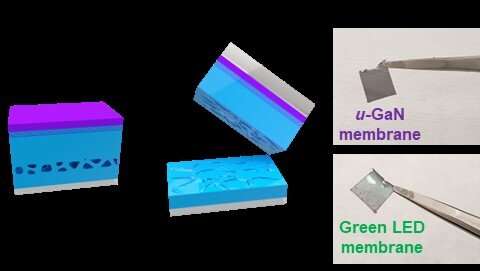Large-scale high-quality III-nitride membranes through microcavity-assisted crack propagation

A new publication from Opto-Electronic Advances discusses large-scale and high-quality III-nitride membranes through microcavity-assisted crack propagation by engineering tensile-stressed Ni layers.
The main purpose of this research was to develop an unprecedented exfoliation technique of large-scale and high-quality III-nitride alloys for practical use in the semiconductor industry. In general, a micrometer thick epitaxial layer for InGaN-based light-emitting diodes (LEDs) are grown on more than hundred micrometer thick sapphire substrates at high temperature (> 1000 °C).
An important point is that the inevitable use of the thick sapphire substrates has led to a lot of shortcomings such as the insulative property, low thermal conductivity, inflexibility, etc. Thus, the LED thin layers grown on the substrates lead to many challenges to develop device applications, especially micro-LED display.
Although these drawbacks can be resolved by removing the substrates, it is challenging due to its strong interfacial fracture toughness with mixed covalent-ionic bonds. Our group's research has been dedicated to removing the substrates at large scale while maintaining the film quality for fabricating III-nitride membranes.
Briefly, intermediate microcavity layers have been introduced to alleviate the interfacial fracture toughness, and the residual tensile-stressed Ni layers were engineered to achieve sufficient energy release rate to conveniently exfoliate the GaN-based layers from the interfaces. Based on this mechanical lift-off technique, we demonstrated large-scale undoped-GaN and green LED membranes and verified the quality by fabricating opto-electronic devices, such as ultraviolet (UV) photodetectors and vertical-type green LEDs after the large-scale exfoliation.
The authors of this article introduce microcavity-assisted crack propagation to obtain large-scale and high-quality III-nitride membranes. Nanoporous structures have been fabricated to be used as a template to grow high-quality GaN-based layers such as undoped-GaN and green LEDs. During the high temperature overgrowth of the layers, the nanoporous structures were transformed into micro-size cavity structures.
The key role for the micro-size cavity structures is primarily to alleviate the original interfacial toughness of GaN by reducing surface area. The reduced interfacial toughness, called the effective interfacial toughness, can be adjusted by modulating the surface porosity and the depth of nanoporous structures. Based on the overgrown target layers (undoped-GaN and green LEDs) with the effective interfacial toughness, we applied tensile-stressed Ni layers, callled a Ni stressor, to provide sufficient energy release rate. The target layers were easily exfoliated at the interfaces of microcavity structures by matching the energy release rate obtained from the Ni stressors, which is deposited by electroplating, to the effective interfacial toughness.
After the large-scale exfoliation, the quality of the undoped-GaN membrane was verified by measuring rocking curves through X-ray diffraction. Moreover, we demonstrated vertical-type UV photodetectors and greed LEDs manufactured by the exfoliated membranes. The devices showed moderate electrical and optical performances, which could also prove that the quality of the thin films is preserved after the large-scale exfoliation.
More information: Jung-Hong Min et al, Large-scale and high-quality III-nitride membranes through microcavity-assisted crack propagation by engineering tensile-stressed Ni layers, Opto-Electronic Science (2022). DOI: 10.29026/oes.2022.220016


















